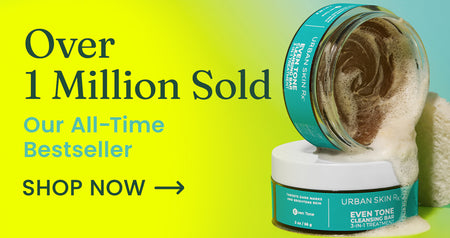A Guide to Treating Sunspots on Your Face

Now that it’s getting cooler out and our hours of warm, glorious sunlight are giving way to sweater weather and wholesome nights in, we’re already starting to miss summer. Not that we don’t love hot chocolate and a cozy knit, but there’s just something about long days in the sun and the feeling of it on your face that you can’t beat, except when it comes to skin damage. Even if you apply your SPF diligently, with time and age—especially if you live in a climate that’s more “slightly less hot summer” than full-on Autumn—it’s hard to save your skin from the sun’s harmful rays. And if your long summer days tended to stretch a bit longer than you initially intended, we’re willing to bet re-applying sunscreen wasn’t always high on your day-out to-do list. There are many ways to combat these blemishes and prevent them from developing again in the future.
What Are Sunspots?
Sunspots are usually skin discoloration that tends to crop up on parts of your body that get the most sun exposure—like your face. They’re more common as you age, and sunspots usually start to develop around the age of 40, so it’s not just one summer of sun that’s going to leave you with sunspots. Instead, it’s many summers stacked on top of each other. However, it’s worth mentioning some skin problems, like actinic keratosis, present similarly to sunspots that are worth having your dermatologist take a look at, just to be safe. If your new skin blemish looks more like a mole, or it’s itchy, or it bleeds and doesn’t heal, you might want to have a professional take a look to make sure it’s not something more serious. Here’s what to look for when you’re suspecting something more serious: Any moles, freckles, or sunspots with changes in color, shape or size Tan spot that is mixed with pink, red, or black areas Tiny freckles are have grown larger or have developed irregular borders If you spot any of these signs, make sure to visit your dermatologist.
What Causes Sunspots?
Sunspots can occur with exposure to UV rays. No matter what your skin tone is, sun exposure stimulates the production of melanin. As this happens repeatedly, you might end up with areas of melanin overproduction which can cause a sunspot. Sunspots can pop up on any area routinely exposed to the sun, including your face, chest, shoulders and the backs of your hands. If your skin is still spot-free, but you live in a climate with lots of sunshine (we’re not jealous, really), or just like to enjoy your summers to the fullest, it’s worth thinking about how to protect your skin from sunspots and other blemishes related to sun damage in the future.
How Do You Prevent Sunspots?
Sunspots often depend on factors like your skin tone, genetic predisposition and sun exposure. But especially with the latter, there are some easy steps you can take to reduce damage caused to your skin by the sun’s wonderful but harmful rays. If you’re a lover of all things skincare, most of these should sound familiar to you!
1. Always Wear SPF
You heard us! Always. Every time you’re going to be outside, or even near a window in the hot sun (long car rides, anybody?), make sure you’ve loaded up on SPF. Our Complexion Protection Moisturizer SPF 30 is a 2-in-1 SPF 30 protector as well as a non-pore clogging moisturizer. This way, your skin is protected from a range of problems the sun can cause for your skin, including dryness. If you’re concerned about your oily complexion, our ShineBlock™ Oil Control Moisturizer SPF 30 will both protect you from the sun with a mineral-active solution that’s effective for all skin tones with a fantastic mattifying moisturizer. Even if you’re looking out the window and seeing gray skies and rain ahead, it’s essential to apply your SPF. Just because you can’t see the sun doesn’t mean you’re safe from pesky UV rays, which are the real culprits when it comes to sun-related skin damage.
2. Avoid the Sun’s Most Intense Times of Day
The sun is at its highest and most potent between 10 AM and 3 PM. If you can avoid being out in the full sun in the afternoon, you’ll drastically cut down on your exposure to harmful UVA and UVB rays. You could also keep a chic yet protective hat on hand if you’re going to be out during the brightest times of the day. Of course, you can’t plan your life around the weather (depending on where you live, you might end up waiting a long time).
3. Cover Up!
No, this is not your mother’s plea to cover yourself up before you go out. And we get it—part of the fun of summer is all about sundresses and tank tops and showing skin that’s been hibernating all winter. And while you can, of course, wear whatever sparks joy as long as you’re wearing sunscreen, it’s worth keeping a couple of light jackets or cardigans in your repertoire, or wide-brimmed hats or linen pants for days where you feel like you can make a statement and keep yourself protected from the sun.
How Do You Treat Sunspots?
We just want to repeat that sunspots don’t need to be treated technically for your peace of mind. As long as you haven’t noticed any of the potentially cancerous signs above or your dermatologist is satisfied that your blemishes are just sunspots, you aren’t going to suffer any health problems related to your sunspots. But if they’re just getting in the way of your best life, there are many things you can do to reduce the appearance of your sunspots, starting from the beginning of your skincare routine.
1. Exfoliate, Exfoliate, Exfoliate
Exfoliating regularly can help with a range of skin challenges, including sunspots. For example, our Purifying 2-in-1 Pumpkin Pore Detox Mask and Scrub features exfoliating Jojoba beads and detoxifying clay. So while you’re cleaning your face, you’re also scrubbing away dead skin cells and encouraging new growth, which can reduce the appearance of your sunspots.
2. Exfoliate Some More
Once you’ve cleansed your skin (bonus points for using a proper physical exfoliator with your face wash), you can double down and use a chemical exfoliator. Try our BrighterDays™ Dark Spot 8% AHA Polish, which has a powerful blend of Alpha Hydroxy Acids and brightening ingredients. Doing so will further help rejuvenate the skin cells on your face and reduce the appearance of sunspots.
3. Find the Perfect Serum
All kinds of serums can help brighten your complexion and reduce the appearance of sunspots. Our Super C Brightening Serum is a great addition that goes a long way to help improve the appearance of uneven skin tone. In addition, vitamin C can help you get your glow back if you feel like sunspots are bringing you down.
4. Try an At-Home Chemical Peel
As you probably know, there are professional chemical peel options that might go a bit deeper if your sunspots are significant and a serious source of frustration to you. But there are also great at-home options to help get your skin to reach its fullest potential. Our Dermapeel Smooth & Glow Treatment 2 Step System is an easy two-step at-home kit that packs a serious punch when it comes to resurfacing, smoothing and overall improving your skin. However, start slow when it comes to chemical peels, and if you have sensitive skin, be sure to patch test it first!
5. Try a Microneedling Tool
Microneedling doesn’t need to be expensive or a hassle! You can do it from the comfort of your own home with our DermRenew Complexion Corrector Microneedling Tool. Microneedling can help improve skin complaints by stimulating all the processes of your skin that keep you looking fresh and bright. By encouraging your skin to renew itself, you can reduce the appearance of dark spots like sunspots.
In Conclusion
While sunspots are harmless, it’s important to speak to your dermatologist if they seem to be growing, changing in shape, bleeding or itching just to make sure there isn’t a more severe issue. Sunspots can be a roadblock on your journey towards perfect, glowing skin. So if you find yourself with dark blemishes after a summer in the sun, it’s crucial to prioritize your SPF application. Plus, you should do a bit of a rethink of your usual skincare routine to make sure you’re targeting your concerns.



